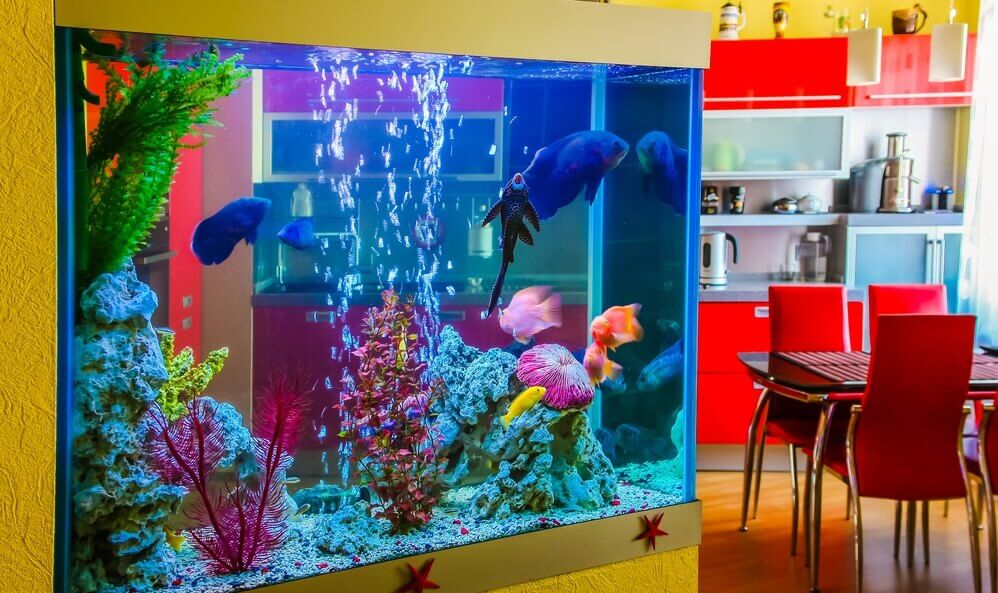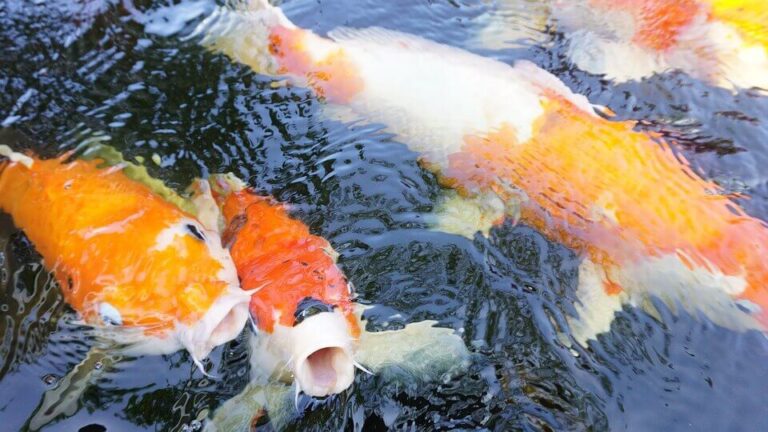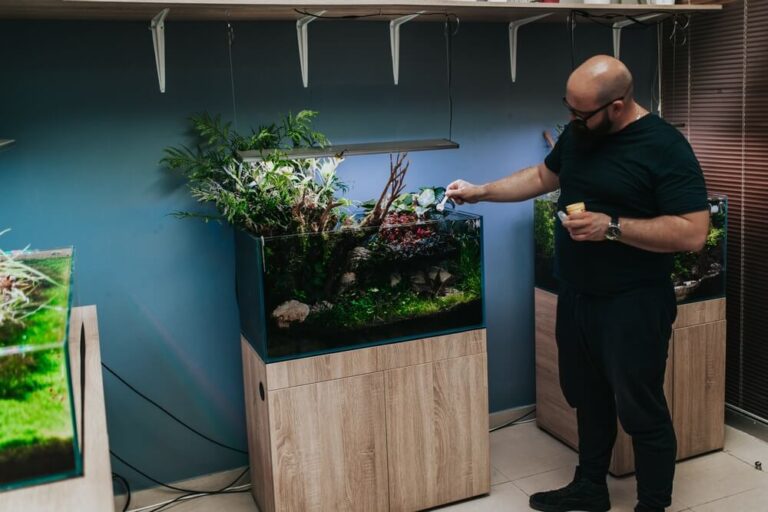Fish tank decorations and aquarium plants are prone to dirt accumulation and algae build-up. They could also form a breeding ground for bad bacteria if left uncleaned. The accumulated dirt can also compromise the water conditions. Therefore, alongside cleaning the tank and changing the water, you need to clean the aquarium decorations and plants regularly.
There are specific ways to clean the fish tank and aquatic decorations. Although you could easily clean them up with soap or detergent, the chemical ingredients used to make them are extremely toxic to fish. We look at some ways to clean these items safely.

How to Clean Fish Tank Decorations and Fake Plants
There are 4 methods you can use to clean tank decorations as follows:
- Using hot water
- Using bleach solution
- Using vinegar
- Using an algae scrubber
Below is a detailed look at each method.
Using Hot Water
This is one of the best methods of cleaning aquarium decorations as it does not expose the fish to any chemicals. It works by killing the algae, which makes it easy to remove.
What You Need
- Dirty aquarium decorations
- Container
- Hot water
- Warm or cold water
- Scrubber
Instructions
- Remove all the decorations from the fish tank, taking care not to disrupt the fish
- Put them in a sink and pour cold water over them to remove any loose dirt
- Meanwhile, bring water to a boil
- Place the decorations in a container and pour the hot water over them
- Let them soak in hot water for 10-15 minutes to kill the algae and harmful bacteria
- Scrub each decoration to remove stuck dirt and algae
- Rinse with warm or cold water
- Let the decorations cool off completely before putting them back in the aquarium
Using Bleach
Bleach does a great job of getting rid of algae. This method is best suited for extreme algae build. However, bleach dulls the color of silk decorations. You also need to rinse the products thoroughly to ensure there is no leftover bleach that could harm the fish or offset the water parameter. Do not use bleach to clean porous decorations such as corals or driftwood.
What You Need
- Dirty aquarium decorations
- Bleach
- Container
- Clean water
- Dechlorinating agent
Instructions
- Remove the decorations from the fish tank
- In a container, mix one portion of bleach with 10 portions of water
- Soak the decorations in the bleach solution for about 15 minutes
- Remove them and rinse them with clean running water. Rinse thoroughly, and if need be, scrub the items to ensure no residual bleach
- Fill the container with water and add a dechlorinating agent
- Soak the cleaned aquarium decorations for 15-30minutes for any residual bleach to be removed
- Rinse again with clean water
- Put them back in the aquarium
Using Vinegar
Vinegar is suitable for cleaning aquarium decorations that have calcium deposits. The calcium dissolves by soaking the decorations in a vinegar solution, ensuring you do not have to scrub the decorations vigorously. Besides, vinegar is safer for fish compared to bleach.
What You Need
- Dirty aquarium decorations
- Vinegar
- Spray bottle
- Water
Instructions
- Remove the decorations from the fish tank
- Mix ½ cup of vinegar with half a gallon of distilled water and put in a spray bottle
- Generously spray each decoration with the vinegar solution and wipe it to remove dirt and calcium
- Rinse with clean running water
- Put them back in the aquarium
Using Scrubbing Tools
You can use different household tools to scrub the aquarium decorations, including toilet scrubbers, toothbrushes, and bottle scrubbers. You could also buy dedicated algae scrubbers. If there is algae or calcium build-up, it will take more effort to scrub the decorations with water.
What You Need
- Dirty aquarium decoration
- Container
- Scrubber
- Water
Instructions
- Remove the decorations from the fish tank
- Put water in a container and let them soak for 15-30 minutes
- Clean each at a time by scrubbing thoroughly
- Then, rinse them and put them back in the aquarium
How to Clean Live Aquarium Plants

Live plants are beneficial in an aquarium. They enhance the aesthetics of the fish tank, provide hiding places for fish, break down fish waste, and help keep the water oxygenated.
However, they are prone to harboring bad bacteria, fungi, parasites, viruses, snails, and algae. Therefore, they require to be cleaned regularly.
Like artificial decorations, there are various ways of cleaning live aquarium plants. However, since the plants are more sensitive, they require delicate care.
Below are some recommended methods for cleaning live aquarium plants.
- Using vinegar
- Using lemon juice and non-iodized salt
- Using hydrogen peroxide
Using Vinegar
Like cleaning artificial decorations with vinegar, a vinegar solution removes algae and kills pathogens yet is not harmful to the fish.
What You Need
- Dirty aquarium plant
- Vinegar
- Container
- Water
Instructions
- Gently uproot the plant from the substrate, or remove it from the fish tank if it is a floating plant
- Mix one gallon of water with 1 cup of vinegar
- Soak the plant in the vinegar solution for about 5 minutes. Alternatively, you may put the mixture in a spray bottle, apply a generous amount to the affected areas, and let it soak for 5-10 minutes
- Gently rub the parts with extensive algae or dirt build-up to remove them
- Then rinse the plant thoroughly with clean water
- Put the plant bank in the tank. Plant the roots firmly in the substrate
Using Lemon Juice
You can use lemon juice if you don’t have vinegar on hand for cleaning. However, out of the two, vinegar is the better option.
What You Need
- Dirty aquarium plant
- Lemon juice
- Non-iodized salt
- Spray bottle
- Water
Instructions
- Mix 3 teaspoons of lemon juice with 1 teaspoon of non-iodized salt to form a paste
- Apply the paste to the affected parts
- Gently rub with your fingers or with a soft brush
- Rinse with cold water
- Return the plant to the tank
Using Hydrogen Peroxide
Hydrogen peroxide in very small amounts can kill growing algae in an aquarium.
What You Need
- Dirty aquarium plant
- Hydrogen peroxide
- Container/ Spray bottle
- Water
Instructions
- Put 1 gallon of water in a clean container
- Add 5ml of hydrogen peroxide and mix properly
- Soak the plant in the hydrogen peroxide solution for about 5 minutes. Alternatively, you may put the mixture in a spray bottle, apply a generous amount to the affected areas, and let it soak for 5-10 minutes
- Gently rub the parts with extensive algae or dirt build-up to remove them
- Then rinse the plant thoroughly with clean water
- Put the plant back in the tank. Plant the roots firmly in the substrate
Note that hydrogen peroxide is an oxidizing agent. Do not soak the plant for too long, as it will get damaged. However, it is safe for fish as any residual amount turns into water and oxygen over time.
Can You Clean Live Aquarium With Bleach?
Although you may be hesitant to clean your live plants with bleach, it is safe to use if you observe the necessary precautions. First, make a 10% or less bleach solution. Only briefly dip the plants in the bleach—do not exceed 5 minutes.
Then rinse off with clean water and rinse again with conditioned water. Bleach is beneficial as it has disinfectant properties to kill any pathogens. It also dislodges algae with ease.
Tips for Cleaning Fish Tank Decorations and Aquarium Plants
- Sanitize the fish tank. It prevents the accumulation of algae and pathogens in the fish tank
- Do not clean all the decorations and live plants at the same time. It disturbs the fish and may cause them to be stressed. Also, do not clean the decorations and plants at the same time as the filter or when changing the filter media
- Monitor water parameters and the fish closely after cleaning the decorations or live plants. There may be a residual cleaning agent that causes a variation in pH and water softness. If that is the case, you want to catch it as early as possible
- Spot clean the live plants. Whenever possible, avoid soaking the entire plant. Rather, spot clean the affected parts
- If the plant has signs of extensive fungi infection or rotting, uproot it immediately and remove it from the fish tank
- Incorporate algae eaters in the fish tank, e.g., shrimps, sailfin mollies, black mollies, etc. They eat algae preventing its build-up
- Maintain optimal light conditions. Do not over-illuminate the fish tank, as excessive light encourages algae growth
Conclusion
Regularly cleaning your aquarium decorations and live plants is as crucial as changing the fish tank’s water and filter media. However, you must choose a suitable and safe cleaning method that will not damage the items or hurt the fish’s health.
Also, take measures to avoid algae, dirt, and pathogen build-up. For example, incorporating algae-eaters, using appropriate lighting settings, and disinfecting the water.






